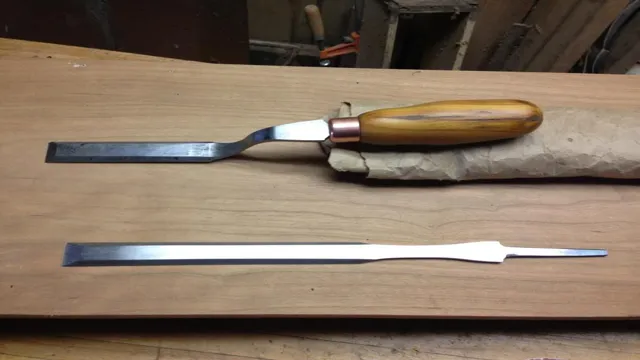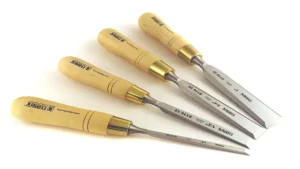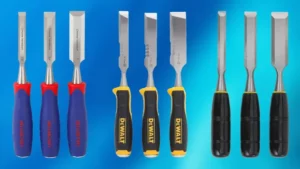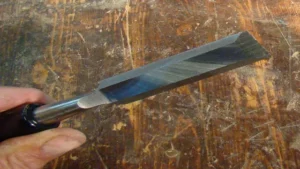Chisels are one of the oldest tools known to mankind, with evidence of their use dating back to ancient civilizations. Even today, chisels remain an essential tool for woodworkers, stonemasons, and metalworkers. But have you ever wondered about the process of how chisels are made? From selecting the right material to forging and honing, the creation of a chisel is a complex process that requires skill and precision.
In this blog, we’ll take a closer look at the fascinating world of chisel-making and explore the steps involved in producing these versatile tools.
Introduction
If you’ve ever used a chisel, you know that it’s an essential tool for woodworking and carving. But have you ever wondered how it’s made? Chisels have a long history and have been used since ancient times. They are made of high-quality steel, which is heated and hammered into shape by skilled craftsmen.
The blade of the chisel is then ground and sharpened to a fine edge, which is essential for precision work. The handle is usually made of wood, and it is attached to the blade with a metal ring or ferrule. Some chisels also have a metal cap at the end of the handle to protect it from damage.
Making a chisel is a labor-intensive process that requires expertise and patience. But the end result is a high-quality tool that can last for generations. So, the next time you use a chisel, think about the craftsmanship that went into making it and appreciate the quality of the tool in your hand.
History of Chisels
As one of the oldest and most essential tools in woodworking, the chisel has a rich and fascinating history. Beginning in the stone age, early humans used sharpened pieces of flint or other hard materials as a primitive form of chisel to shape and carve wood and stone. Over time, chisels evolved from simple handheld tools to more complex designs utilizing metal blades and handles.
In the medieval period, chisels became an essential component in the construction of grand cathedrals and castles, and during the Renaissance, they were used to create intricate patterns and designs in ornate furniture. Today, chisels are still a ubiquitous tool in woodworking, used for everything from rough shaping to fine detail work. Whether you’re a professional carpenter or a hobbyist woodworker, there’s no denying the versatility and usefulness of a good chisel.
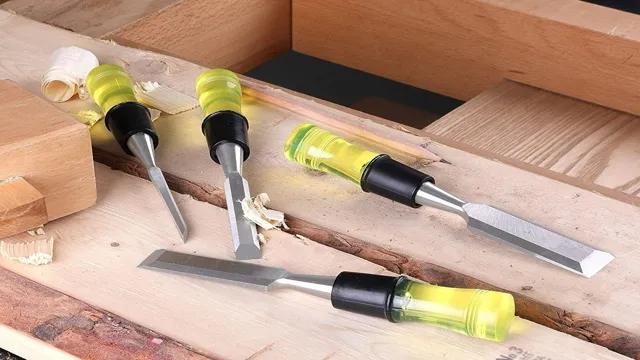
Types of Chisels
Chisels are a class of woodworking tools that have been in use for centuries to carve, shape, and cut wood, stone, and other materials. These tools come in different types and sizes, each with a unique purpose and design. If you are a woodworker or just starting with woodworking, you should know about the types of chisels and how they can be utilized.
They include bench chisels, mortise chisels, paring chisels, and fishtail chisels. Bench chisels are the most commonly used chisels and can be used for general woodworking tasks. Mortise chisels are designed for making deep cuts, whereas paring chisels are ideal for making shallow and precise cuts.
On the other hand, fishtail chisels are excellent for reaching tight areas. Each type of chisel has different features to suit specific woodworking tasks and mastering their usage can lead to excellent results in your woodworking project.
Materials Used for Chisels
How it’s made chisels? Chisels are tools with a sharp edge used for carving, cutting, or shaping wood, stone, metal, or other materials. They come in different sizes, shapes, and designs. The materials used for making chisels may vary depending on the intended use and quality.
High-quality chisels are typically made from high-carbon or high-speed steel, which is durable and retains its sharp edge for a long time. Carbon steel, which is an alloy of carbon and iron, is also commonly used for chisel blades because of its ability to hold a sharp edge and its hardness. Some chisel blades are made of titanium-coated carbon steel for added durability and corrosion resistance.
The handles of chisels may be made from wood, plastic, or other materials to provide a comfortable and firm grip. For more specialized chisels, such as those used for stone carving, the blades are often made of tungsten carbide or diamond. These materials are much harder than steel and can withstand the rigors of carving dense and tough materials.
In summary, the materials used for making chisels depend on the purpose, but high-carbon or high-speed steel, carbon steel, titanium-coated carbon steel, tungsten carbide, and diamond are commonly used.
Steel Grades for Chisels
When it comes to making chisels, the choice of steel grade is crucial as it directly affects the tool’s performance and longevity. High carbon steel is a popular option for chisels due to its excellent sharpness and edge retention, which makes it ideal for woodworking projects. However, high carbon steel does require more maintenance and care to prevent rust and corrosion.
M2 steel is another popular choice for chisels due to its high wear resistance and toughness. This type of steel is often used in industrial applications where the chisel is subjected to heavy use and abuse. Stainless steel is also a good option for chisels as it is highly resistant to rust and corrosion, making it ideal for use in damp conditions or where hygiene is essential.
Ultimately, the steel grade used for chisels will depend on the specific application and the user’s preference for sharpness, durability, and maintenance requirements.
Selecting the Right Handle Material
When it comes to selecting the right handle material for chisels, there are a variety of options available to choose from. The most common materials used for chisel handles are wood, plastic, and metal. Wood handles are traditional and offer a classic look and feel but may require more maintenance to prevent cracking or splitting.
Plastic handles are durable and low-maintenance, although they may not provide the same level of grip as wood or metal handles. Metal handles are strong and long-lasting, but they may not be as comfortable to hold for extended periods. Ultimately, the choice of handle material depends on your individual preferences as a woodworker and what feels most comfortable in your hand during extended use.
Manufacturing Process
When talking about chisel manufacturing, we can say that it’s a process that requires precision and skill. First, the raw materials that will be used to make the chisels are selected, which is typically high-quality steel or iron. Then, the metal is heated and molded into the desired shape; this process is called forging.
After that, the chisels are sharpened to their final shape, an important step that requires expertise since a poorly sharpened chisel can make a significant difference in the outcome of a project. Lastly, the handles are added to the chisels, making them easy to hold and use. The quality of the handle material and its shape makes a big difference in the overall feel and usability of the tool.
Whether the handles are made of wood, plastic, or rubber, they must be ergonomically designed to ensure that the user gets the most comfortable grip and maximum control. These are the fundamental steps involved in the chisel manufacturing process, ensuring that the end product is a high-quality tool that will last for long and produce outstanding results. It’s fascinating how a seemingly simple tool like a chisel involves so much attention to detail.
Forging the Blade
Forging a blade is a highly skilled task that involves a complex manufacturing process. The first step is to select the right type of steel that will provide the optimal balance of strength and hardness. This is crucial as it determines the overall quality of the finished blade.
Once the steel is selected, it is heated to a high temperature and shaped using a hammer and anvil. This process, called forging, helps to align the steel molecules in a specific direction, which makes the blade stronger and more durable. The blade is then tempered, which involves heating it to a specific temperature and cooling it rapidly to increase its hardness.
This further enhances its strength and toughness, ensuring that it can handle even the toughest of tasks. Finally, the blade is sharpened to a razor edge, and any final touches, such as polishing, are made. The manufacturing process is highly specialized and requires a great deal of skill and experience to produce a high-quality blade that is both strong and durable.
Machining and Grinding the Blade
Machining and Grinding the Blade: A Crucial Step in the Manufacturing Process One of the most critical phases in producing a blade is the machining and grinding stage. This step is where the blade is shaped and honed to perfection, ensuring that it is strong and robust enough for its intended purpose. The first step in this process is to carefully machine the blade from a block of high-quality raw material using precise tools.
This stage requires extreme accuracy and attention to detail, as even the slightest mistake can compromise the blade’s strength and durability. Once the blade is machined to the desired shape, it is then necessary to grind it down to its final dimensions. This procedure requires a highly skilled operator and specialized grinding equipment.
The grinding process involves rubbing the blade surface against an abrasive material with varying levels of grit until the desired finish and sharpness are achieved. The quality of the machining and grinding process can have a significant impact on the finished blade’s performance. A well-machined blade will have consistent dimensions and a smooth surface that allows it to efficiently slice through materials.
On the other hand, poorly machined or ground blades can have uneven surfaces that compromise their strength and sharpness. As a result, it is essential to rely on a team of experienced machinists and grinder operators who have the expertise and specialized equipment necessary to produce high-quality blades consistently. In conclusion, machining and grinding the blade are crucial steps in the blade manufacturing process.
It’s a complex process that requires the utmost precision and skill to ensure that the blade performs optimally in its intended use. Investing in high-quality materials, skilled labor, and specialized equipment can guarantee that the blades produced are strong, durable, and extraordinarily efficient. Ultimately, this results in high-performance tools that will stand the test of time and exceed your expectations.
Heat Treatment
Heat treatment is a critical manufacturing process that aims to alter the physical and chemical properties of a material. The process involves heating the material to a specific temperature, holding it for a specified period, and then cooling it to room temperature. This process can strengthen the material, improve its hardness and toughness, as well as increase its durability.
Heat treatment is typically used in the production of metallic materials, such as steel, to enhance their mechanical properties. It is also used in the manufacturing of non-metallic materials, such as glass, ceramics, and polymers. The benefits of heat treatment are many, including improved product performance, reduced manufacturing costs, and increased product life.
However, to achieve optimal results, it is crucial to choose the right combination of temperature and time for the specific material being treated. Overall, heat treatment is a vital manufacturing process that plays a crucial role in producing high-quality products that meet industry standards.
Final Steps
Now that you’ve learned about the initial steps in the process of making chisels, let’s talk about the final steps. Once the chisels are forged and hardened, they’ll need to undergo some additional processes before they can be sold as finished products. The chisels will be polished and sharpened to ensure they’re effective for use.
The polishing process involves using a variety of tools and polishing compounds to refine the surface of the chisel and remove any rough spots. Once the chisel has been polished, it will be sharpened. This process involves using a sharpening stone to carefully sharpen the blade of the chisel.
Finally, the chisel will be stamped with the manufacturer’s logo and other identifying information. After this, the chisel is ready to be shipped off to retailers or directly to customers. So, the next time you use a chisel, remember the intricate process it went through to get there.
Assembling the Chisel
Assembling the chisel may seem like a daunting task, but with a little patience and attention to detail, it can be quite simple. The final steps can make all the difference in ensuring a smooth and clean cut. The first step is to attach the blade securely to the handle by inserting the tang into the socket and using a mallet to tap it in firmly.
Next, make sure the blade is centered and straight before tightening the ferrule. Finally, hone the blade to a razor-sharp edge using a sharpening stone or honing rod. With these final steps complete, your chisel is ready to be used for all your woodworking needs.
Remember to always handle the chisel with care and keep it sharp to prevent accidents.
Quality Control Measures
Final Steps in Quality Control Measures: The key to achieving high-quality products lies in the final steps of quality control measures. Once the products have been carefully crafted and produced, they go through rigorous testing and evaluation before they are deemed ready for market. This final step involves identifying any errors, defects, or imperfections that may have been missed during the manufacturing process.
A team of trained professionals carefully inspects the final product, making sure that each item meets all the required specifications and standards. This quality control process ensures that consumers receive a product that is safe, reliable, and of the highest quality. By prioritizing quality control measures, businesses can maintain their reputation in the market and ultimately enhance customer satisfaction.
Conclusion
After watching “How It’s Made: Chisels,” it’s clear that these tools require a perfect balance of precision and strength. From selecting the right metal to creating the intricate shapes and angles, every step in the process is crucial. But let’s be real, even the most well-made chisel won’t do its job without a skilled craftsman behind it.
So, if you’re looking to channel your inner woodworker, remember that it takes both the tools and the talent to carve out success.”
FAQs
What materials are used to make chisels?
Chisels can be made from a variety of materials such as high-carbon steel, chrome-vanadium steel, and tungsten-carbide.
How are chisels forged?
Chisels are typically made through a process of forging, in which the metal is heated and shaped under a hammer or press.
What is the difference between a bevel edge chisel and a firmer chisel?
Bevel edge chisels have a slimmer blade and are more commonly used for finer work, while firmer chisels have a thicker blade and are better suited for heavier cutting tasks.
Can chisels be sharpened at home?
Yes, chisels can be sharpened at home using a sharpening stone or grinder. However, it is important to take special care to maintain the correct angle and avoid damaging the blade.
How long do chisels typically last?
The lifespan of a chisel can vary depending on factors such as the quality of the metal, how frequently it is used, and how well it is maintained. With proper care, a high-quality chisel can last for many years.
What are some common uses for chisels?
Chisels are commonly used in woodworking, stone carving, and metalworking for tasks such as shaping, carving, and cutting.
How do you choose the right chisel for a specific task?
When choosing a chisel, consider factors such as the type of material being worked with, the size and shape of the workpiece, and the desired level of precision. Consult with a knowledgeable salesperson or expert for guidance.
